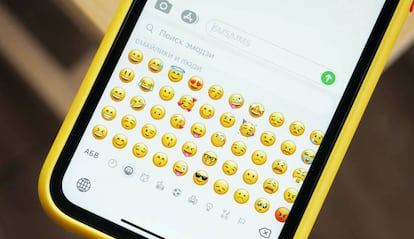🔥👀👍: A guide for understanding 25 key emojis that often appear in online conversations
Laughing faces with tears and symbols with hearts are by far the most commonly used ones

While 💀 symbolizes death for some people, teenagers use the skull emoji to mean that they’re dying of laughter. In the last 20 years, the way people communicate has undergone a major transformation due to technological advances. According to the Unicode consortium, of the more than 3,000 existing emojis, the 10 most commonly used ones around the world are 😂 ❤️ 🤣 👍 😭 🙏 😘 🥰 😍 😊. EL PAÍS has investigated how these and other emojis (such as 🔥, 👍 or 👀) are interpreted in text messages and on social media.
😂
According to Unicode, 92% of the online population uses emojis. 😂 is the most commonly used one in the world: it appears in 5% of all messages that contain an emoji. In fact, it is so popular that it was the Oxford Dictionary’s 2015 word of the year. Alejandro Rodríguez Velayos, 16, uses it when something is very funny. Cristina Vela Delfa, a PhD in Linguistics, professor in the Spanish Language Department at the University of Valladolid (Spain) and the co-author of the book Los emojis en la interacción digital escrita [Emojis in Written Online Interactions], uses it when she is joking.
🤣
Another variant is 🤣, which usually conveys even more hysterical laughter than 😂 and comes from the acronym ROFL (“Rolling on the Floor Laughing”).
❤️
The only emoji that comes close to 😂 in terms of popularity is this red heart. It was used in eight out of every 1,000 tweets in 2020. While heart emojis are popular throughout the year, their use increases in February around Valentine’s Day. Ana Isabel Velayos Jiménez, who is 54 years old (and Alejandro’s mother), uses this emoji after a conversation with someone she cares about: “It’s like saying I love you.” According to the Emojipedia website, it is also used to express gratitude and appreciation and usually appears alongside words like thank you, birthday, happy or good.
💜
Different color hearts are often used together. Sometimes they share the same meaning, but they can also have other connotations. Purple is a favorite of fans of the Korean group BTS. It is also common to see a purple heart in tweets and messages related to feminism. Patricia Ruiz Guevara, 31, often uses it when talking “about something related to sisterhood or in a personal conversation with a friend.”
💚
On Twitter, this symbol is often used when referring to the K-pop group NCT. But in Spain, it is used by the far-right Vox party.
💛
The yellow heart is often used alongside the sunflower emoji (🌻) and is meant to brighten up a tweet or message. “A friend read that it was the color of friendship, and so between us, we use this heart,” comments Ruiz.
💙
According to Emojipedia, blue is the corporate heart because “brands love to use it.” The website goes on to highlight that it usually appears on Twitter next to words like coupon, promotion or discount.
🤍
The white heart often accompanies this emoji of the pleading face (🥺), although it is not clear why. It also appears alongside words like angel, goodnight, peace and remember, as well as to pay tribute to someone who has passed away. “Forever in my heart, Dad. Rest In Peace 🤍,” writes one user on Twitter.
🖤
One might expect the black heart to appear alongside emojis of a bat (🦇) or chains (⛓️), as indicated by Emojipedia. But it is used much like the other colored hearts.
🧡
The main reason people use the orange heart is simply to place it alongside blue, yellow, purple, green and red hearts.
🤎
According to Emojipedia, the brown heart is the least commonly used one and primarily relates to discussions about racial identity. It often appears next to words like black, brown, skin and color, as well as foods and beverages like chocolate and coffee.
👍
The thumbs-up emoji can be used to indicate approval. Eduardo Hermoso Díaz, 83, uses it when he receives something interesting to say that he liked it or to agree with the sender. However, in certain contexts, this emoji can also be interpreted as passive-aggressive or sarcastic. In fact, Ana de la Morena Rubio, 24, uses it when she doesn’t want to respond to a message: “It’s like saying ‘ok’ or ‘whatever you say.’”
🔥
“That shirt looks 🔥 on you.” Teenager Rodriguez gives this example to explain the meaning of the flame emoji, which can signify “looking hot or passion.” But this emoji does not mean the same thing to all people. “Emojis are by nature very polysemic and their meanings change a lot depending on the age group or speech community that uses them,” explains linguist Vela. For Velayos, the mother of a teenager, the flame means that “a situation is on fire,” while octogenarian Hermoso uses it when “it’s very hot.”
💀
Many young people use the skull emoji on social media to mean that they’re dying of laughter. “It comes from the fact that we’re embarrassed by the laughter emoji and we [were dying of laughter],” explained Cecilia Sacristan Hidalgo, 19, helping us understand how young people use the symbol. But if Hermoso received this emoji, he would think someone wants to tell him “something related to death.”
👀
To de la Morena, these eyes mean, “I’m watching you.” But there are also those who use them in response to the photo of someone attractive on the internet. This is another example of how the same emoji can have different meanings depending on the context. While for Velayos it means to be wide-eyed, Hermoso uses it to connote something else: “When someone sends me a nice picture or landscape, I put several eyes like I have seen it and that it is pretty.”
👉👈
Separately, it is an emoji of a hand pointing to the right with the index finger and another one pointing to the left. But when combined, the meaning changes. Rodriguez explains that 👉👈 “literally serves to say “uwu,” which is used to refer to someone you like or with whom you have a close friendship.” What does uwu mean? A cute face. For her part, Vela uses “these little hands to point, especially to parts of a text.”
😭
While Velayos uses this emoji to express sorrow, Vela uses it to indicate that she has messed up or that something is making her very angry. In addition to reflecting inconsolable pain, this face can also convey other intense feelings, such as uncontrollable laughter, pride or overwhelming joy.
🙏
“When I talk about people who have passed away or who are sick and I hope they get better, I use the two little hands together, as if they were praying,” says Hermoso. For her part, Vela uses this emoji as a symbol for “please” when asking for something. She also notes that originally this emoji referred to a high five. In addition, it can represent a respectful greeting or a sign of worship in many Southeast Asian religions and cultures, such as Hinduism or Buddhism.
😘 🥰😍
Hermoso usually sends the red heart emoji (❤️) to his wife and daughters. “If I write to friends or people I know or have a certain relationship with, I use [emojis] with smaller hearts like 😘, 🥰 or 😍.” These emojis usually convey feelings of love and affection more generally. There are thousands of examples on Twitter. For instance: “If he doesn’t look at you like Bradley Cooper looks at Lady Gaga, then it’s not 😍,” one user tweeted next to a video of both artists.
😊
“This is the modern version of :-), so for me, it’s the emoji par excellence; I’m old for a reason,” jokes Vela. She uses it to add “a positive element or show joy” in a message. According to research published in Biological Psychology, some people react to emojis that elicit pleasant affective states, much as they react to human faces.
🙃
“The upside-down face serves to indicate irony or show that the idea conveyed by a message is really crazy or… that it has turned our minds upside down,” says Vela. Rodriguez uses it to convey sarcasm. An example? “Of course I like her 🙃.” According to Emojipedia, this emoji can have multiple meanings, indicating irony, joking and the idea of foolishness or stupidity.
✨
“I use these sparks or stars to lend a festive air to messages or simply embellish them,” Vela says. De la Morena employs them at the end of a sentence, to “give it a little more depth,” and Rodriguez utilizes them to say that something sparkles. She gives the following example: “That dress on you: ✨.” This emoji can also express positive feelings, such as love, happiness, beauty and gratitude.
💩
Vela says that one could write “a treatise” on this emoji; in addition to representing excrement, she has even seen it used as chocolate ice cream. “At first, it was strange because it does not have the same meaning here in the West as [it does] in Japanese culture, which is where the references for most emojis originate; there it refers to good luck,” she says. Of course, it can also mean that “something sucks.” As in, “I think I’m going to miss the train 💩,” says De la Morena.
Sign up for our weekly newsletter to get more English-language news coverage from EL PAÍS USA Edition
Tu suscripción se está usando en otro dispositivo
¿Quieres añadir otro usuario a tu suscripción?
Si continúas leyendo en este dispositivo, no se podrá leer en el otro.
FlechaTu suscripción se está usando en otro dispositivo y solo puedes acceder a EL PAÍS desde un dispositivo a la vez.
Si quieres compartir tu cuenta, cambia tu suscripción a la modalidad Premium, así podrás añadir otro usuario. Cada uno accederá con su propia cuenta de email, lo que os permitirá personalizar vuestra experiencia en EL PAÍS.
¿Tienes una suscripción de empresa? Accede aquí para contratar más cuentas.
En el caso de no saber quién está usando tu cuenta, te recomendamos cambiar tu contraseña aquí.
Si decides continuar compartiendo tu cuenta, este mensaje se mostrará en tu dispositivo y en el de la otra persona que está usando tu cuenta de forma indefinida, afectando a tu experiencia de lectura. Puedes consultar aquí los términos y condiciones de la suscripción digital.











































